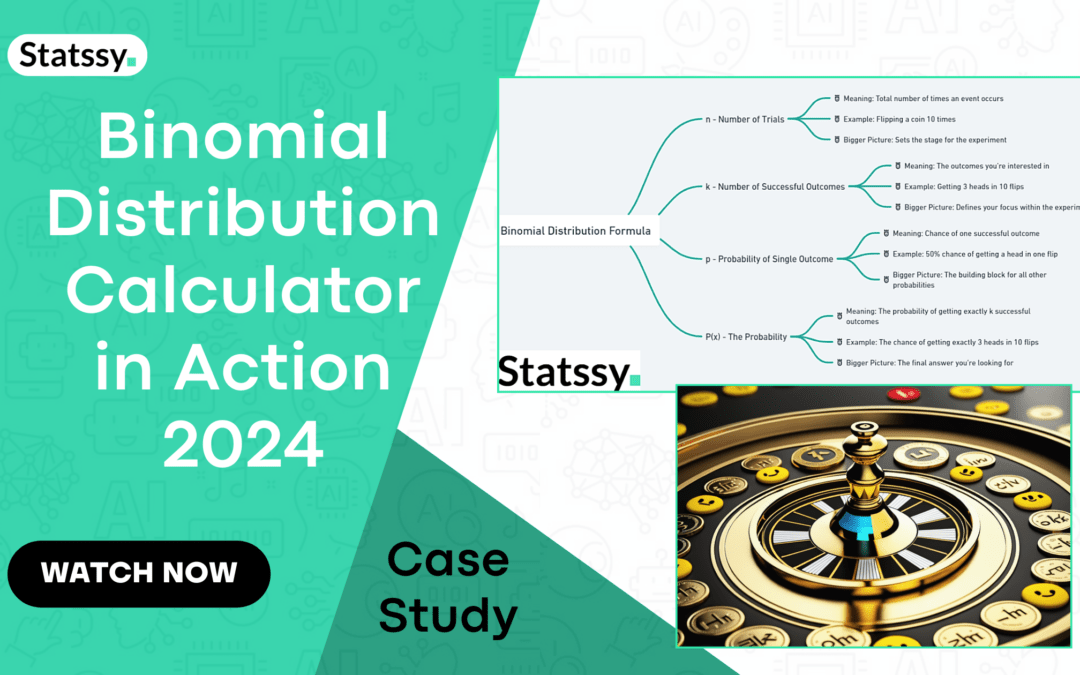Introduction
Hey there, future statistician! Welcome to your go-to guide for understanding Binomial Distribution. You might be wondering, “Why should I even care about this?” Well, you’re in for a treat!
Table of Contents
Why You Should Care About Binomial Distribution
Binomial Distribution is like the secret sauce that spices up everything from video games to healthcare , and even your chances of getting that dream job! It’s all around us, shaping the world in ways you might not even realize. So, if you’re curious about how life’s probabilities work, you’re in the right place!
What’s the Big Deal with Binomial Distribution?
So, you’re intrigued and ready to dive deeper? Awesome! Let’s get down to the nitty-gritty and explore what makes Binomial Distribution such a hot topic.
The Basics
First things first, let’s talk about what Binomial Distribution actually is. Imagine you’re flipping a coin. Heads or tails? Simple, right? Now, what if you flip it 10 times? Or 100 times? Binomial Distribution helps you predict the outcomes of these kinds of events. It’s like the crystal ball of probability!
A Quick History Lesson : Binomial Distribution Calculator
Okay, history might not be everyone’s cup of tea , but trust us, this is cool! Binomial Distribution has been around for centuries. It started with gamblers wanting to up their game , moved to scientists making groundbreaking discoveries , and now it’s in the tech that powers your favorite apps .
The Magic Formula
Ready to pull back the curtain and reveal the magic formula? Don’t worry, we won’t get too mathy on you. We promise it’s easier than it looks!
The Nitty-Gritty
So, the formula for Binomial Distribution looks something like this:
Px=nCkpk1-pn-k
Looks like alphabet soup, right? But once you get the hang of it, it’s as easy as pie!
What Do These Symbols Even Mean?
Okay, let’s decode this formula, shall we?
- n is the number of trials (like how many times you flip a coin).
- k is the number of successful outcomes you’re interested in (like getting 3 heads).
- p is the probability of a single successful outcome (like the chance of getting a head in one flip).
Real Talk: Case Studies
Ever wondered how all this theory translates into real-world scenarios? Well, let’s get into some case studies that show Binomial Distribution in action!
| Case Study | Scenario | Variables | Application of Binomial Distribution | Outcome |
|---|---|---|---|---|
| Case Study 1: The Coin Flip Challenge | You flip a coin 10 times. What are the odds of getting exactly 6 heads? | n = 10, k = 6, p = 0.5 | Use the Binomial Distribution formula to calculate the probability of getting exactly 6 heads in 10 flips. | The probability is approximately 20.5%. |
| Case Study 2: Medical Trial | A new medication claims to relieve headaches in 90% of cases. If 12 people are tested, what’s the likelihood that it will be effective for at least 10 of them? | n = 12, k = 10, p = 0.9 | Use the formula to find the probability of the medication being effective for at least 10 out of 12 people. | The probability is approximately 93.4%. |
| Case Study 3: Gaming Loot Boxes | In a video game, a loot box has a 30% chance of containing a rare item. If you open 5 loot boxes, what are the odds of getting at least one rare item? | n = 5, k = 1, p = 0.3 | Use Binomial Distribution to calculate the odds of getting at least one rare item in 5 loot boxes. | The probability is approximately 83.2%. |
The Good, The Bad, and The Complicated
So, you’ve seen how Binomial Distribution can be a game-changer in various scenarios. But like anything in life, it has its ups and downs. Let’s weigh them, shall we? Binomial Distribution Calculator
The Upsides
- Easy to Understand: One of the best things about Binomial Distribution is its simplicity. You don’t need to be a math whiz to get the hang of it!
- Widely Applicable: Whether you’re in finance, healthcare, or even gaming, this formula has got you covered.
- Predictive Power: It’s like having a mini crystal ball. It can help you make informed decisions by predicting outcomes.
The Downsides
- Limited Scope: Binomial Distribution only works well when you have two possible outcomes (like success and failure). So, it’s not ideal for more complex scenarios.
- Assumes Independence: The formula assumes that each trial is independent of the others, which isn’t always the case in real life.
- Can Be Misleading: If not used carefully, it can give you a false sense of certainty. Always remember, it’s a tool, not a guarantee!
Compared to What?
You might be wondering how Binomial Distribution stacks up against other probability distributions like Normal Distribution or Poisson Distribution.
- Normal Distribution: Great for continuous data but not as straightforward for binary outcomes.
- Poisson Distribution: Ideal for rare events over a period but not as intuitive for binary scenarios.


